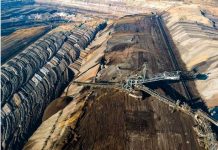OGIB INTERVIEW WITH ROBIN MILLS IN DUBAI
 Robin Mills is author of “The Myth of the Oil Crisis” and is CEO of Qamar Energy, a consultancy that advises clients on strategic, commercial and business opportunities in Middle East oil and gas. I interviewed Mills–a Briton who has lived in Dubai for 12 years, while in Dubai in October.
Robin Mills is author of “The Myth of the Oil Crisis” and is CEO of Qamar Energy, a consultancy that advises clients on strategic, commercial and business opportunities in Middle East oil and gas. I interviewed Mills–a Briton who has lived in Dubai for 12 years, while in Dubai in October.
I asked him
1) How fast will Iranian production come back online
2) How much spare capacity does Saudi Arabia really have?
3) How bad is the tension between Sunni’s and Shi’a in eastern Saudi Arabia?
3) What is the West’s misconceptions of the energy industry and life in the Middle East.
Keith: You say The Biggest Oil Story of 2016 will be Iran. Expand on that for me.
Robin: Sure. Iranian crude oil productions is down to about 2.8 million barrels a day and pre-sanctions it was at let’s say 3.6 million or so and so it’s lost about 800,000.
Iran has also been constrained on its ability to export condensate, so that’s probably another 400,000 barrels of condensate production which it has had difficulty selling and that is going to increase to 800,000 of production capacity or even a million barrels of condensate over the next few years.
Now with the end of sanctions on Iran—which is expected early next year—a lot of that oil is going to come back online. Now how quickly is still an open question but my own belief is it will be fairly quick.
So that means 800,000 barrels a day; perhaps a bit more, including the condensate on the market.
Now if you think of global demand growth in a typical year as being 1 to 1.2 million barrels per day—that means the return of Iranian Oil is enough to make up for all global demand growth or a very large part of global demand growth in 2016 and therefore to offset the declines in US shale production. At least in my view that keeps oil prices relatively depressed during 2016.
Keith: How quickly will they be able to restart their fields?
Robin: I think that in most cases relatively quick. The fields were shut down in an orderly way and it wasn’t like Libya where there was a sudden war and the fields were abandoned. The Iranians had a lot of warning this is going to happen. There’s been no physical damage to the fields so in most cases they shouldn’t have too much trouble restarting them at the original production levels or close to them.
Keith: They have quite an experienced and talented workforce.
Robin: Yeah they do. They have a lot of skilled people, a lot of experienced people. Now they may not be up with the latest technologies but at least in terms of doing the basics there, they’re pretty capable and well informed and they will, of course, be getting during the next year – if sanctions are lifted – they’ll have access to international service companies which will help them optimize production.
So they probably will have lost some production from where they were pre-sanctions because of under investment and lack of maintenance, etc. But I don’t expect a large amount and so they should be able to come online relatively quickly.
Now how quickly can they place all this oil on the world market, a rather oversupplied market? That’s a question and, of course, they can always place it if they’re willing to discount enough.
They also have a lot of stored oil; they have 40 or 45 million barrels of stored oil, which they will look to sell fairly quickly. Of course that’s just in storage tanks that can come back on the market immediately. It’s a marketing problem of how quickly can they sell it? So if you think of 40 or 45 million barrels, imagine they sell that over 3 months say 300,000 barrels a day compared to 3 months that’s a large extraction of supply even if for only a limited period.
Keith: Are they desperate for foreign capital? Would they be willing to really discount that or do you think they’d actually put a strategy in that would kind of keep the market the least impacted as possible?
Robin: Well I think there’s 2 separate questions there. One is what’s their marketing strategy for the short term in terms of getting rid of all this stored oil and getting back to their kind of whatever production level they achieve and managing to sell all of that? That probably will be a period of months, and okay I think they will discount but they probably won’t discount just to any level, they’ll have to feed this back in the market, they have to phase it in.
But in the longer term the Oil Minister is pretty clear—‘we’re going to get back to our pre-sanction level. Whatever OPEC says…we’re not going to talk about any production cuts until we are back at our original level because their viewpoint is in the last 3 or 4 years we’ve lost production, the other OPEC members have gained at our expense and so if anyone has to make production cuts to protect the price it’s not going to be us.’
Keith: So what’s Iran’s cost base compared to Saudi Arabia and Iraq–are they pretty much the same in that whole area or is one of those 3 drastically different in any way?
________________________________________________________
It’s November 12–I expect to get rich today–on this one stock.
It’s trading right at it’s highs, about to break out.
To get the details before it’s too late, CLICK HERE
_________________________________________________________
Robin: I think they’re all very similar. The Iranian fields, in general, are a bit more mature and so somewhat higher costs but not dramatically higher and still far lower than the current oil price. So any extra oil they can sell is still attractive to them and they have some major new Greenfield developments which are very similar to those in Iraq and have the same kinds of costs.
Now okay there are some other issues in working there, some US sanctions will still remain in place and so there will be some caution about working there. But on the other hand, unlike Iraq there’s no problem with security and as you said, there are a lot of skills, experienced Iranians to work there and so in some ways you can expect those new fields to be cheaper than fields in Iraq.
Keith: How do you see western oil majors working in Iran, post-sanctions?
Robin: They’ve got 2 major Greenfields–Azadegan and Yadavaran–which are pretty much on the Iraqi border. In fact, they probably cross over into fields in Iraq. They were discovered a few years back and have only been partly developed. The Chinese companies are working on them but have not made much progress and, in fact, the Iranians kicked out the Chinese from one of those fields because of their lack of progress.
So these large fields will be up there for western majors to get involved in. Plus there’s a lot of medium sized fields and a lot of brown field redevelopments and various other opportunities.
Keith: So they’re ripe for the picking.
Robin: Yes very much so.
Keith: So just to give investors an idea here—because we’ve become so accustomed to press releases that talk about the size and production of a shale well–what kind of IP 30’s are we talking about for these new fields in Iran?
Robin: Well I mean it would be in the thousands of barrels a day even up to 10,000 barrels a day for the better fields. And, of course, unlike the shale wells these wells decline slowly and so they might have an annual decline rate of 5 or 10% max. So these wells will be major producers for 10 years or more.
Keith: Even in the first year they would only be that low?
Robin: Yeah, especially in the first year there might be very little or no decline cause it’s such a big field, a single well or a few wells doesn’t draw down the pressure very much. I mean unlike a shale well where you’re only accessing the part of the reservoir that you fracked. In a conventional field like this the well has ultimately seen the whole field which may be, in this case, maybe 50 kilometers long or more.
Keith: Got you. When you talk about condensate here, their condensate levels are around 400,000 barrels a day and it’s going to go up quite a bit. Does that have any impact on global oil pricing or is it completely separate?
Robin: I think that will have another major significant impact on global overall price because condensate is basically a light oil and competes pretty directly with a lot of the lighter US shale oil.
So it will have an impact; it will push down the overall level of oil price but particularly it will push down the level of light crudes and condensates but relatively make the kind of medium and heavy grades more attractive.
Keith: So the Nigerians and the Americans would be the most hit?
Robin: Yes it would affect the US, it would affect Nigeria, Libya, Algeria these kinds of African producers that have now been…because of the US these African producers have been forced to turn to Asia for sales and now they’ll find they’re competing with Iran in an already competitive market. But the producers of medium and heavy crude who are more diesel rich they will be better protected.
Keith: OK…I want to move over to Saudi Arabia for a moment. To me, The Big Question is—what is their true spare capacity right now? Because until the US started to cut back production in the last 6 months, Saudi Arabia was the only country with any significant spare capacity. I think Saudi spare capacity is a huge factor in the price of oil.
The Saudis have been producing 10 ½ million barrels a day for quite a while now…they say they can produce 12 million. What do you think? You’ve been over there for 10 years and you’re very close to Riyadh. What do you think their true spare capacity is?
Robin: Yeah this is a really tricky one to get…I mean the Saudis say 12.5 million sustainable capacity and they also say they have tested all the parts of that individually. So at different times they’ve produced all these fields at maximum rates so they know the whole thing works.
I think the message you get digging a bit deeper is yeah…maybe…but it would be a real stretch and it would be like not sustainable for very long and it would really become overproducing these fields. Maybe it’s like not 12 ½ but like 12 million.
But like sustainable?–something they could keep there for a long time? Perhaps more like 11 million. Now that would mean, of course, it’s only a half a million or something of spare capacity which is minimal in the global total.
So at the margin it’s quite a bit tighter than you might think.
And Saudi’s own domestic consumption is rising pretty fast. They add 150,000 barrels a day of domestic consumption every year. So if there’s no new field developments they will either have to cut exports or they’ll have to use up their spare capacity within the next 3 years or so and there are no real signs for major new oil developments.
I mean they have a whole list of things they could do but there’s nothing that’s been sanctioned, nothing seems close to being sanctioned either.
So again that’s a bit of a puzzle to me and at some point the Saudis are going to have to say ‘yes we’re going to go ahead with new field developments or redevelopments and then boost our overall capacity’. But they don’t seem in a hurry to do that.
Keith: I’m guessing that when they decide to do something they don’t need to wait a 1 ½ years for a permit like you do in the Western world?
Robin: No they can make a decision…these field development plans have been, it’s known and they’re on the shelf and they’ve been carefully studied and all ready to go if it’s something that was intended previously but not awarded.
So they can go ahead pretty quickly and most of their projects have been executed and the Khurais field which I think had 1.2 million barrels a day a few years back was executed very quickly, efficiently and smoothly when you think of such a giant project.
They’re not going to get held in politics like they would with Keystone or something like that in North America.
Keith: My other question is…how big a deal is the Shi’a-Sunni unrest in Saudi Arabia, particularly in the Eastern part where you’ve got the minorities being the largest there? In the oil fields area in the Eastern part of the country is tension higher there? Is terrorism potential a little more than what the market is getting credit for do you think? Or is that really just not an issue right now?
Robin: The tension is a real thing. The feeling by the Shi’a community that they’re marshalized and discriminated against is very real as well. It’s hard to say how much a threat it poses to the oil fields. Yes it’s in that area but the oil fields are very well defended of course.
Multiple layers of security, large security forces and the Shi’a population is only thought to be about 15% of the Saudi population as a whole. So it’s significant and they’re mostly concentrated in the East where the oil fields are, but it’s also still very much a minority.
I think the Saudi government has always been quite successful at keeping control internally. Now can they continue to do that in a period of low oil prices and financial problems and so on? I think down the road there will be questions of Saudi Arabia but at the moment, at least the short term security seems to be very effective.
Keith: Alright, we’ve talked Iran and Saudi Arabia so far…is there a part of the more broad, Middle Eastern situation either politically or geo-politically or on the logistics oil production side that you think is really misunderstood here in the West or is it all very straightforward?
Is there any kind of trend you see of people not appreciating one part of the Middle Eastern politics or oil logistics?
Robin: I see a lot of misconceptions but I’m trying to think of one of those that actually affect all markets significantly. Just one example if you talk about specific oil, like I can talk about Kurdistan. If you talk about Iraq then you get a lot of news coverage of Kurdish oil and the companies of Kurdistan, which is a very interesting story and quite a significant one.
But I think it gets overexposed vs. Southern Iraq. If you think of Southern Iraq is producing now over 4 million barrels a day and the Kurds producing the 500 or 600,000 barrels a day you can see they’re only a small part of the Iraqi oil story, but they get a lot of media exposure because it’s a safer place, it’s easier for journalists to get there. There are some smaller companies there that have to, of course, talk up their discoveries. It’s a bit more of a glamorous story than the south and the south is where the real oil action is. So I think that’s one example.
Another one is you mentioned the Shi’a-Sunni divide and that is a real issue and perhaps it’s become more real over the past few years. But I think it’s not a Cold War, like 2 kind of opposing ideological blocks facing each other off.
I mean there are many local conflicts and you’re find Sunnis against Sunnis and Shi’a against Shi’a, you’ll find Sunni’s cooperating with Shi’a, you’ll find splits within…like within the Shi’a in southern Iraq, for example, you have different factions.
You have, for example, Turkey which is largely a Sunni country but in some ways its policies are opposed to those of the Saudis and the UAE. So it’s actually much more complicated and you can’t see it as a kind of simple black and white division.
Keith: Robin, what great information. Thank you for sharing. We have to end here, but you helped me and my readers understand a bit more about oil in the Middle East. Thank you.
Robin: My pleasure. Thank you for having me and we’ll speak again.
AND I DO SPEAK WITH ROBIN AGAIN—on natural gas in the Middle East. Stay tuned for my second interview with Robin in the near future.
Keith Schaefer








